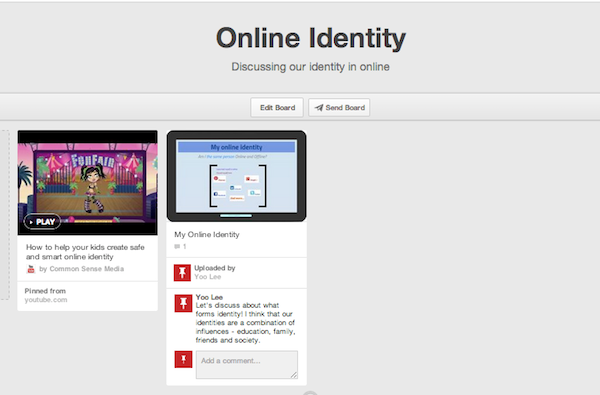Digital Story Telling Tool: Prezi & Pintrest
My Digital Story:
If the screen is not large enough or have a problem to play the Prezi presentation use the link here.
My Pintrest “Online Identity” activity board. Click here to access the Pintrest board.
Prezi & Pintrest as a story telling tool
There is vast amount of information generated everyday online. Students need to know how to examine and evaluate the information and present it with digital tools or medias. The partnership for 21st Century Skills identified information, media and technology skills as the 21st century learning skills (Partnership for 21st century skills, n.d). Therefore, it is crucial to acquire these skills to be successful in 21st learning due to exponential technology advancement.
The Prezi activity is designed to encourage students to participate actively to acquire both multiliteracies and digital citizenships by creating presentations based on their own social media stories. Research has shown that people learn best not when they participate passively – receiving information or simply viewing content – but when they participate actively – exploring, experimenting, and expressing themselves, as well as designing, creating and inventing with materials. (Resnick, 2002)
I selected Prezi and Pintrest as my digital story telling tools to promote multi literacies and help students explore their online identity as a part of a digital citizenship lesson.
Students will gain multiliteracies – digital literacy, information literacy, visual literacy, and multimedia literacy – through creating their own stories with Prezi and Pintrest. The New London Group presented a theoretical overview of the connections between the changing social environment facing students and teachers and a new approach to literacy pedagogy that they call “multiliteracies” (New London Group, 1996). Literacy involves gaining the skills and knowledge to read and interpret varying texts and artifacts, and to successfully navigate and negotiate knowledge in society. Traditional literacy is defined as the ability to read, write, listen and speak. However, the new form of literacy requires multiliteracies – digital literacy, information literacy, visual literacy, and multimedia literacy – as well. Prezi and Pintrest will offer the following literacies:
- Presenting information through Prezi – utilizing images, structuring information in a concise and meaningful way, examining information and giving feedback to each other on individual presentations – will help students attain digital and visual literacies.
- The process of finding and evaluating information for their presentation will promote information literacy.
- Collective boards in Pintrest will provide students and a teachers with the opportunity to construct knowledge collaboratively as a learning community (Scardamalia & Bereiter, p. 272)
- Students will learn how to create or use images, and audio and video files through the Prezi and Pintrest activity
How the story will be incorporated in the classroom
Target audiences are grades 10-12 who can create their own Prezi and Pintrest accounts with parents’ consent. There is the alternative downloadable exercise file for students who cannot participate in the online activities. The digital story is aimed for a part of the multiliteracies and digital citizenship class.
The story is about finding one’s identity online. There are a lot of social media websites and cloud based web services companies since web 2.0 technologies came into the main stream on Internet. Social media and cloud-based web service access are not limited only to adults. Most social media sites and web-based cloud software offer the service to users aged 13 and above with parents’ consent. It is inevitable that students will be using those technologies outside class. However, they don’t have many opportunities to be educated about digital citizenship in class. They know how to use the technologies in a limited way but they don’t know how to be good digital citizens. The activity to create their own story of online identity based on their social media activities will allow them to reflect on how they behave in digital space and to think about their offline and online identities . The process will also help them acquire the 21st learning kills – digital literacy, information literacy, visual literacy, and multimedia literacy.
Reference:
Information, Media and Technology skills (n.d). Partnership for 21st Century Skills. Retrieved from: http://www.p21.org/about-us/p21-framework/61
New London Group. (1996) “A Pedagogy of multiliteracies: Designing social futures.” Harvard Educational Review 66.1: 60-92.
Resnick, M. (2002). Rethinking Learning in the Digital Age. In The Global Information Technology Report: Readiness for the Networked World, edited by G. Kirkman. Oxford University Press.
Scardamalia, M. and Bereiter, C. (1993). Support for knowledge-building communities. The Journal of Learning Sciences 3(3), 265-283.

